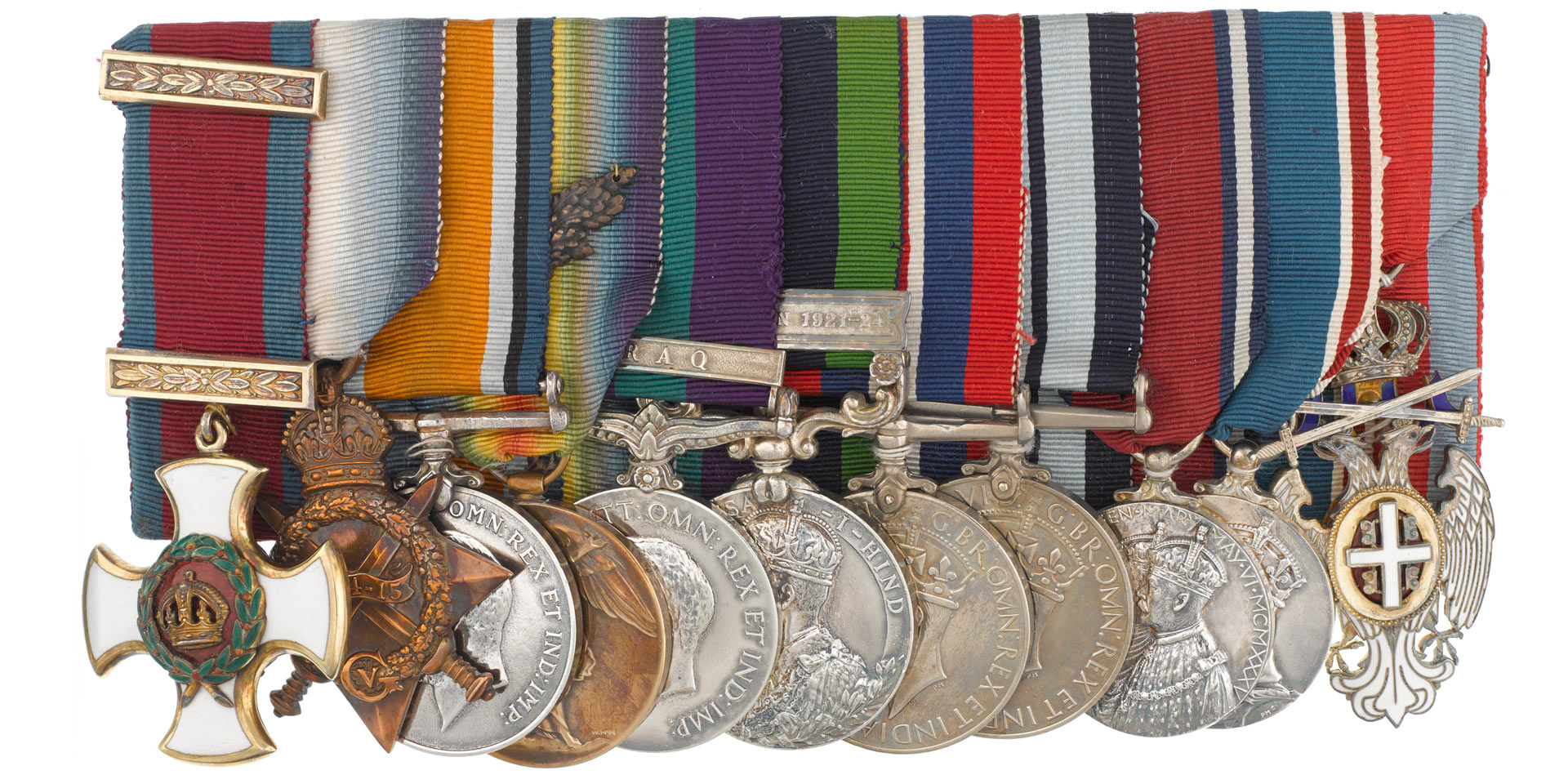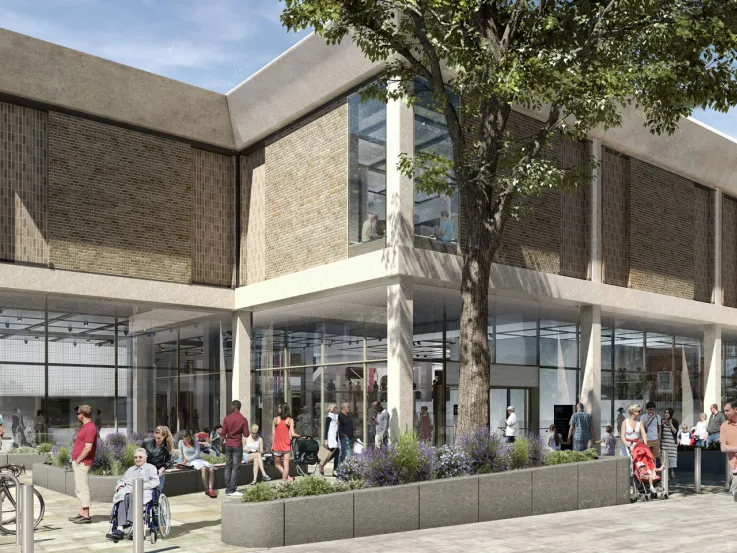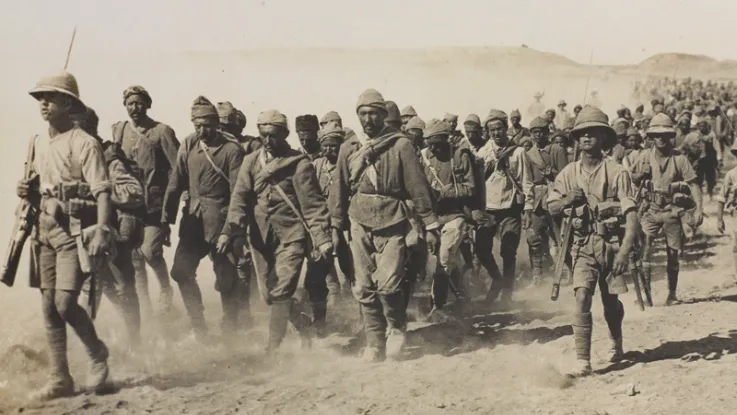Medal awarded to Indian soldier demonstrates substantial role India played in First World War
In October 1918, Indian medical officer Captain Heerajee Cursetjee was awarded the Distinguished Service Order (DSO) for his bravery during the final stages of the Mesopotamia (now Iraq) campaign – a theatre of war in which the soldiers of the Indian Army played a vital role.
Following the British capture of Baghdad in March 1917, the Turks withdrew north and established their headquarters at Mosul. The British resumed their offensive in late February 1918, but this petered out in April after they had to divert troops to Palestine to support the operations there.
For the next few months, the British were content to consolidate their positions and keep their forces trained and ready for action until the fighting against the Turks could be renewed.
Success in Palestine in the autumn of 1918 meant that armistice negotiations with the Turks had begun, but the British attempted to strengthen their bargaining position in Mesopotamia by renewing their advance on the Tigris. They also hoped to secure the oil-rich Mosul region. At this stage of the war Indian troops were playing the leading role in the Mesopotamia campaign. By 1918 there were 304,000 Indian soldiers stationed there, as opposed to 107,000 British.
An Anglo-Indian force, that included Cursetjee and the 14th King George's Own Ferozepore Sikhs, left Baghdad under the command of General Sir Alexander Cobbe on 23 October 1918. The following day they reached the Little Zab River, where the Turkish 6th Army was deployed. Its commander, Ismail Hakki Bey, fearing his rear was about to be overrun, began withdrawing towards Sharqat to the north. The British caught up with the Turks just south of Mushak during the evening of 25 October.
On one part of the front the 1st Highland Light Infantry (HLI) attacked, but met stiff Turkish resistance. During the night the 14th Sikhs were ordered to move up on their right and carry out a supporting attack at dawn. This was met with heavy machine-gun and artillery fire. The Sikhs suffered 67 killed and over 250 wounded. During the next two days Cursetjee and his fellow medics worked constantly under fire and had to tend and evacuate the casualties of both the 14th Sikhs and HLI.
As the Turkish withdrawal continued, Cobbe attacked again on 29 October at Sharqat. Both the HLI and the 14th Sikhs advanced as part of 51st Brigade, but the neighbouring 34th Brigade was held up and the attack stalled. During this period of fighting Cursetjee again regularly treated the wounded under fire.
Although British and Indian cavalry units had made some progress elsewhere, the attack looked like failing. But Ismail Hakki Bey, aware of the armistice talks at Mudros, decided to try and save his men rather than continue to resist. He therefore surrendered the following day. The British then advanced on Mosul which they occupied on 14 November.
For his bravery during both engagements Cursetjee was awarded the Distinguished Service Order (DSO). This British military decoration recognised ‘meritorious and distinguished service’ by officers. His citation in ‘The London Gazette’ of 26 May 1919 stated:
'For conspicuous gallantry and devotion to duty at Mushaq, 26th-27th October and at Sharquat, 29th October. Throughout the operations he displayed the greatest zeal and disregard for danger while tending the wounded under heavy fire, working unceasingly for forty-eight hours. He has previously rendered excellent service, and once was severely wounded.'
Notes to editors
For more information, please contact Claire Blackshaw at cblackshaw@nam.ac.uk or 020 7881 2433.
- Visit First World War in Focus at http://ww1.nam.ac.uk
- Major General Cursetjee’s uniform and medals are on display in the permanent Battle gallery, on the 3rd floor, at the National Army Museum.
- Entrance to the Museum is free, with varying prices for special exhibitions.
- Opening hours are: daily, 10am – 5.30pm, until 8pm first Wednesday each month and closed on 25, 26 December and 1 January.
Join in the conversation:
- Twitter: @NAM_London
- Facebook: facebook.com/NationalArmyMuseum
- Instagram: @NAM_London
About Heerajee Cursetjee
Heerajee Jehangir Manockjee Cursetjee (1885-1964) was born in Bombay, India, on 14 August 1885 to a prominent Parsi family. The Parsis were followers of the Zoroastrian faith and descendants of Persians who had migrated to India in the 7th century after the Islamic conquest of their homeland.
After a private schooling in India, Cursetjee travelled to England and studied medicine at Gonville and Caius College, Cambridge, and at the London Hospital. A keen polo player and hunter, Cursetjee initially wanted to be a cavalry officer, but his small physique counted against him. He was therefore commissioned as a lieutenant with the Indian Medical Service (IMS) on 27 January 1912, having obtained his Conjoint diploma the year before.
Cursetjee initially served as medical officer with the 14th King George's Own Ferozepore Sikhs in Egypt during the defence of the Suez Canal in 1914-15. He was promoted to captain on 27 January 1915. That same year he also fought at Gallipoli, where his unit landed at ‘V’ Beach, Cape Helles, on 1 May 1915 with 29th Indian Brigade. He took part in the second and third battles for Krithia (May and June 1915) and was wounded by shell splinters on 28 June 1915 while attending to a private of the Royal Fusiliers. Cursetjee was evacuated from the Dardanelles in December 1915.
His regiment then served in Egypt and Bushire in Persia for the remainder of 1916. That year, Cursetjee also obtained his MB BCh (Cantab). In February 1917 the 14th Sikhs arrived at Basra in Mesopotamia. After several months guarding lines of communications, they moved on to garrison Baghdad and Falluja before joining the final British advance.
Cursetjee’s regiment remained in Mesopotamia until the end of the war. From 1919 until 1921 he served with them in Waziristan and the Khyber Pass on the North West Frontier of India. He was promoted to major in the IMS on 27 January 1924.
Brevetted lieutenant-colonel on 1 January 1931, he was then appointed deputy assistant director of medical services, and was promoted to the substantive rank of lieutenant-colonel on 27 July. In 1938, he was appointed to command the hospitals of the Lucknow Military District. Cursetjee was promoted to full colonel on 1 December that year.
On 23 February 1941, Cursetjee was appointed an Honorary Surgeon to King George VI. On 12 July that year, he was also promoted to major-general, becoming one of the first Indians to achieve general officer rank in the British Indian Army.
During the Second World War (1939-45), the IMS was integrated with the Indian Army Medical Corps and Cursetjee was soon appointed Deputy Director of Medical Services, Northern Command. He transferred to the North-Western Command in the same role in April 1942.
He was appointed a Companion of the Order of the Star of India in the 1943 New Year Honours, and was knighted as a Knight Commander of the Order of the Indian Empire in 1946.
He finally retired on 1 June 1946, later settling in Tetbury, Gloucestershire. He died in a car accident on 26 July 1964.
Medals and honours:
- India General Service Medal 1908-35,
- 1914-15 Star
- British War Medal 1914-20
- Allied Victory Medal
- General Service Medal 1918-62,
- Distinguished Service Order, 1919
- George V Silver Jubilee Medal 1935,
- King George VI Coronation Medal 1937
- Serbian Order of the White Eagle, Badge of the 5th Class
- British War Medal 1939-45,
- Companion of the Order of the Star of India, 1943
- Knight Commander of the Order of the Indian Empire, 1946
National Army Museum
The National Army Museum is the leading authority on the history of Our Army. Founded in 1960 by Royal Charter and established for the purpose of collecting, preserving and exhibiting objects and records relating to the Land Forces of the British Crown, it is a museum that moves, inspires, challenges, educates and entertains.
The Museum seeks to tell the story of Our Army, the personal experiences of the soldiers who have served in it and to connect the British public and its army, demonstrating how the role of Our Army and its actions are still relevant today.
Heritage Lottery Fund
Thanks to National Lottery players, we invest money to help people across the UK explore, enjoy and protect the heritage they care about - from the archaeology under our feet to the historic parks and buildings we love, from precious memories and collections to rare wildlife.
For more information, please contact Katie Owen, HLF press office on 020 7591 6036 or 07973 613820 (out of hours mobile).



